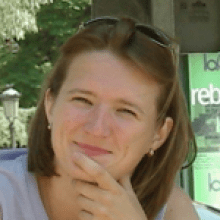Evolutionary Genetics of Interactions Group
Members

Ingénieur d'études CDD
CNRS

Maître de conférences
UCBL
Tel: 04 72 43 29 16
Post-doc
CNRS

Chargé de recherche
CNRS
Tel: 33 04 72 43 29 12

Maîtresse de conférence universitaire
UCBL
Tel: 04 72 43 29 16

Professeur des universités
UCBL

Doctorante
CNRS
Tel: 04 72 44 81 42

Chargée de recherche
CNRS
Tel: 33 04 72 44 81 01

Doctorante
INSA
Tel: 04 72 44 81 42

Maîtresse de conférences
UCBL
Tel: 04 72 43 29 10

Doctorante
UCBL
Tel: 04 72 44 81 42
Doctorante
UCBL
Doctorante
UCBL
Assistante ingénieure CDD
UCBL

Technicien CDD
UCBL

Maître de conférence universitaire
UCBL
Tel: 33 04 72 44 81 01

Directeur de recherche
CNRS
Tel: 33 04 72 43 19 21

Professeure des universités
UCBL
Tel: 33 04 72 44 82 16
Professeur des universités
VetAgro-Sup
Tel: 33 04 78 87 27 02
Living systems are made up of a multitude of interlocking levels of organization, involving cooperation and conflict. Cooperation and the selection of systems operating in a coordinated manner has allowed so-called "major" evolutionary transitions, towards new scales of individuality, such as the eukaryotic cell. Nevertheless, natural selection continues to operate at all scales, generating possible evolutionary conflicts between the different components of the individual.
Our research is in line with this perspective, and aims to better understand the nature and evolutionary implications of the interactions between the multiple components of organisms, from genes to symbiotic bacteria, viruses and transposable elements. We also explore the impact of these interactions on the dynamics of genetic information, through horizontal transfer, or on genetic innovation and adaptation, through domestication. Our research, mainly experimental, but also theoretical, is implemented on arthropod models, and is mainly related to genetics and evolutionary genomics.
The team is structured along two main axis:
- Intragenomic interactions: transposable elements (resp. Marie Fablet)
Ex1: The evolutionary dynamics of transposable elements (TEs) in genomes, in relation to their natural variability. Our models include natural populations of Drosophila melanogaster and D. simulans, as well as species of agronomic or societal interest, such as the invasive species D. suzukii or the tiger mosquito Aedes albopictus.
Ex2: Interactions between ET control and anti-viral immunity. We are studying the molecular mechanisms of RNA interference at the origin of the entanglement of these two processes, as well as the co-evolutionary implications, using experimental infections of different viruses on several Drosophila lines.
People involved : CV, MB, MF
- Symbiosis, the driving force of evolution (resp. Natacha Kremer)
Ex1 : Certain symbiotic bacteria provide metabolic capacities that the insect lacks. We are analysing these interactions in haematophagous insects (bedbugs, ticks) and phytophagous insects (the whitefly Bemisia tabaci) using approaches combining phenotype analysis, genetics, physiology and metabolomics.
Ex2: Parasitoid insects have domesticated viral genes enabling them to bypass the immune responses of their hosts. We are studying the frequency and adaptive significance of these events and, more generally, looking into the factors structuring horizontal transfers in host-parasitoid communities.
People involved: NK, LM, LZ, JMD, JV, FV, SC
Publications
Display of 331 to 360 publications on 392 in total
An efficient procedure for purification of the obligate intracellular Wolbachia pipientis and representative amplification of its genome by multiple displacement amplification
Applied and Environmental Microbiology . 71 : 6910-6917
Journal article
see the publicationTransposable elements in mosquitoes
Cytogenetics and Genome Research . 110 : 500--509
Journal article
see the publicationIs genome size influenced by colonization of new environments in dipteran species ?
Molecular Ecology . 14 : 869-878
Journal article
see the publicationNew regulatory regions of Drosophila 412 retrotransposable element generated by recombination
Molecular Biology and Evolution . 22 : 747-757
Journal article
see the publicationAdaptive male effects on female ageing in seed beetles
Proceedings of the Royal Society B: Biological Sciences . 272 : 2485-2489
Journal article
see the publicationWolbachia requierement for oogenesis : occurence within the genus Asobara (Hynoptera, Braconidae) and evidence for intraspecific variation in A. tabida.
Heredity . 95 : 394-400
Journal article
see the publicationSuperparasitism acceptance and patch-leaving mechanisms in parasitoids: A comparison between two sympatric wasps
Animal Behaviour . 69 : 1227-1234
Journal article
see the publicationCost induced by viral particles manipulating superparasitism behaviour in the parasitoid Leptopilina boulardi
Parasitology . 131 : 161-168
Journal article
see the publicationÉvaluation des effets sublétaux d'insecticides sur des insectes auxiliaires entomophages
incollection . -- : 85-96
Journal article
see the publicationEfficient procedure for purification of obligate intracellular Wolbachia pipientis and representative amplification of its génome by multiple-pisplacement amplification
Applied and Environmental Microbiology . 71 ( 11 ) : 6910-6917
Journal article
see the publicationWolbachia requirement for oogenesis: occurrence within the genus Asobara (Hymenoptera Braconidae) and evidence for intraspecific variation in A. tabida
Heredity . -- : 267-282
Journal article
see the publicationWhat transposable elements tell us about genome organization and evolution: the case of Drosophila
Cytogenetics and Genome Researchearch . 110 : 25-34
Journal article
see the publicationCytogenetic mechanism and genetic consequences of thelytoky in the wasp Trichogramma cacoeciae
Heredity . 93 : 592-596
Journal article
see the publicationVirulence multiple infections and regulation of symbiotic population in the Wolbachia-Asobara tabida symbiosis
Genetics . 168 : 181-189
Journal article
see the publicationTransposable element dynamics in two sibling species: Drosophila melanogaster and Drosophila simulans
Genetica . 120 : 115-123
Journal article
see the publicationDiversity distribution and specificity of WO phage infection in Wolbachia of four insect species
Insect Molecular Biology . 13 : 147-153
Journal article
see the publicationIntra-individual coexistence of a Wolbachia strain required for host oogenesis with two strains inducing cytoplasmic incompatibility in the wasp Asobara tabida
Evolution - International Journal of Organic Evolution . 58 : 2167-2174
Journal article
see the publicationL`influence des éléments transposables sur la taille des génomes
Journal de la Société de Biologie . 198 : 413-417
Journal article
see the publicationVariation of the genome size estimate with environmental conditions in Drosophila melanogaster.
Cytometry Part A . 55 ( 1 ) : 43-9
DOI: 10.1002/cyto.a.10061
Journal article
see the publicationReduction in the sex ratio of the progeny of a parasitoid wasp (Trichogramma brassicae) surviving the insecticide chlorpyrifos
Archives of Environmental Contamination and Toxicology . 45 : 203-208
Journal article
see the publicationDivergent strategies in low temperature environment for the sibling species Drosophila melanogaster and D. simulans: Overwintering in extension border areas of France and comparison with African populations
Evolutionary Ecology . 17 : 523-548.
Journal article
see the publicationPhenotypic plasticity of sternopleural bristle number in temperate and tropical populations of Drosophila melanogaster
Genetical Research . 81 : 25-32
Journal article
see the publicationStrain-specific regulation of intracellular Wolbachia density in multiply infected insects
Molecular Ecology . 12 : 3459-3465
Journal article
see the publicationVariation of the genome size estimate with environmental conditions in Drosophila melanogaster
Cytometry - Part A . 55A : 43-49
Journal article
see the publicationInfectious behavior in a parasitoid
Science . 302 ( 5652 ) : 1930
Journal article
see the publicationBetween- and within-host species selection on cytoplasmic incompatibility-inducing Wolbachia in haplodiploids
Evolution - International Journal of Organic Evolution . 57 : 421-427
Journal article
see the publicationWorldwide distribution of transposable element copy number in natural populations of Drosophila simulans
Evolution - International Journal of Organic Evolution . 57 : 159-167
Journal article
see the publicationWORLDWIDE DISTRIBUTION OF TRANSPOSABLE ELEMENT COPY NUMBER IN NATURAL POPULATIONS OF DROSOPHILA SIMULANS
Evolution - International Journal of Organic Evolution . 57 ( 1 ) : 159-167
Journal article
see the publicationStimulating effects of the insecticide chlorpyrifos on host searching and infestation efficacy of a parasitoid wasp.
Pest Management Science . 58 ( 4 ) : 321-328
DOI: 10.1002/ps.454
Journal article
see the publicationStimulating effects of the insecticide chlorpyrifos on host searching and infestation efficacy of a parasitoid wasp
Pest Management Science . 58 : 321-328
Journal article
see the publication